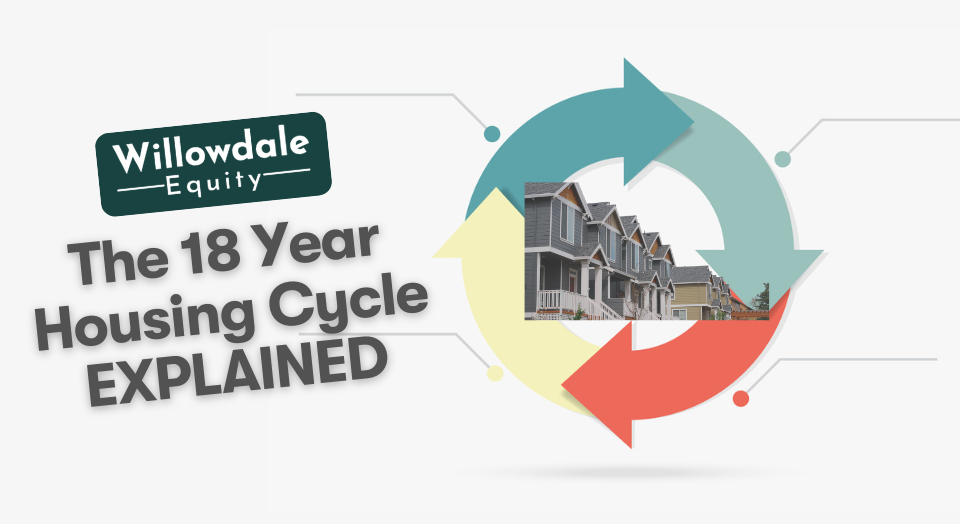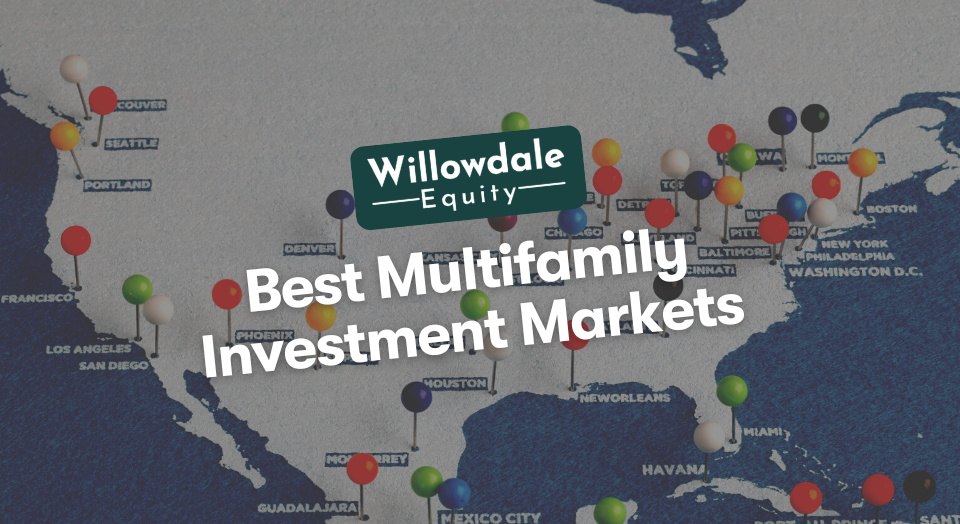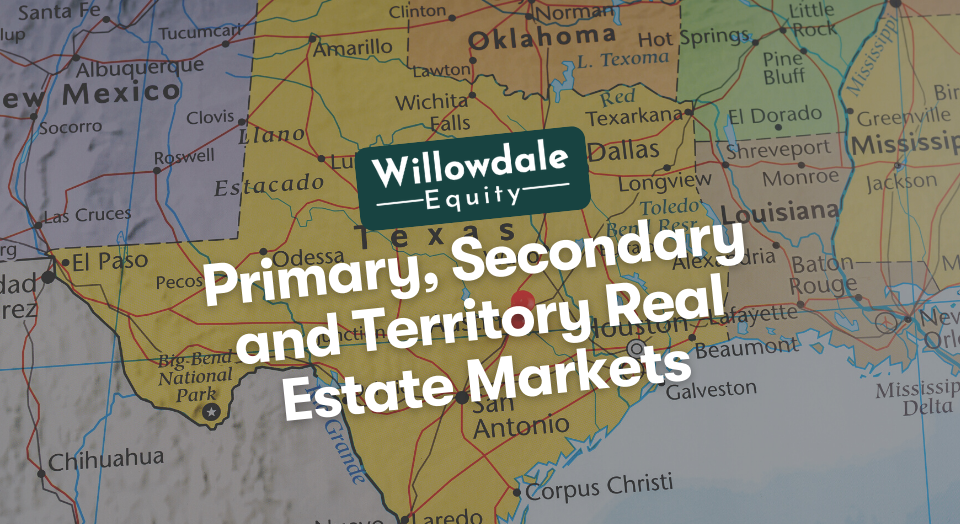
The 18 Year Housing Cycle EXPLAINED
This article is part of our guide on buying real estate during a recession, available here.
You might be familiar with the 18-year property cycle as a landlord. It has clearly defined growth, economic downturn, and recovery periods, much like the economic cycle. It could signal whether we’re experiencing a boom or bust. It is beneficial if you’re considering purchasing or selling a house. Although the theory is based on analysis and predictions made on the U.K. property market, some economics have seen some parallels with the U.S. housing market.
The 18-year property cycle is undoubtedly one of the most critical concepts for property investors to understand. You won’t entirely be able to predict the future after understanding the property cycle. However, you’ll be as close as anyone of your competitors in the real estate marketplace.
Key Takeaways
-
The 18-year property cycle is a series of recurrent occurrences or patterns in all real estate markets. It follows a fairly predictable cycle, and it comprises four distinct phases. I’ll take you through each stage while providing insight into what typically occurs at each one.
-
Fred Harrison gained notoriety for foreseeing the financial crisis of 2007–2008 as early as 1998. In his 2005 book “Boom and Bust,” he made the case that the U.K. property market goes through an 18-year cycle.
-
The mechanics of supply and demand, apart from land, keep prices balanced in practically every market, whether for goods like vehicles or labor like a hairstylist.The central idea is that supply and demand coordinate to keep costs steady over time.
What Is the 18 Year Property Cycle Exactly?
The 18-year property cycle is a series of recurrent occurrences or patterns in all real estate markets. It follows a fairly predictable cycle, and it comprises four distinct phases. I’ll take you through each stage while providing insight into what typically occurs at each one.
Fred Harrison gained notoriety for foreseeing the financial crisis of 2007–2008 as early as 1998. In his 2005 book “Boom and Bust,” he made the case that the U.K. property market goes through an 18-year cycle. Harrison provided evidence to support his claim by showing how the 18-Year cycle repeatedly occurred throughout 200 years of U.K. property price data. Harrison’s assertions are supported by the market crashes of 1953–1954, 1971–1972, and 1989–1990.
According to the notion, the real estate market goes through a recession for three to four years after a crash. As lenders and property investors leave the market and the demand for real estate declines, an abundance of supply anticipated during the bubble will continue to drive down house prices. The recovery phase, which lasts for 6-7 years and sees property prices gradually increase, comes next.
After the phase of recovery, a brief market correction occurs during which prices pause—investors’ concerns about the continuity of growth cause this to last for around two years. The boom phase begins at that point. Low borrowing costs and government stimulus programs increase demand, but supply cannot keep up. It causes rapid growth in housing prices and rental rates over a timeframe of 5–6 years. The next cycle begins with the peak and crash that follows.
What Is The Recovery Phase of the 18-Year Property Cycle?

Let’s begin with the phase of recovery. Prices have recently dropped due to a recent market crash at the start of this period. In truth, prices have dropped to a point where favorable yields and cash flows exist. It occurs as a result of prices declining faster than rents. It is an excellent opportunity to acquire real estate for risk-taking property investors with extra cash due to the rental growth.
There won’t be many active buyers in the market at this stage of the 18-year property cycle. The average property investor will still be nursing their wounds after being severely burned during the crash. They might have made significant losses by selling when the market was at its lowest. Even though it seems that the worst of the recession is behind us and property values have stabilized, the media will stay pessimistic.
The recovery phase begins as rents and cash flows rise and bold investors sustain prices. More purchasers are gaining the courage to reenter the market. Prices for real estate start to soar. First, this occurs in the most prominent areas. The early price increase is most prevalent in large cities and popular areas in city centers. It then starts to spread.
What Is the Explosive/Boom Phase of the 18-Year Property Cycle?

Another seven years pass during this phase. Appreciation might reach double digits at this time. Many new market investors may not remember the previous crash because sentiment is high.
The “Winner’s Curse” refers to the final two years of the explosion or boom phase. It is the worst possible time to purchase real estate. The market is at its strongest during this time. Investors entering this market would instantly see a decline in value, and it would take a long time for them to recover.
House prices begin to rise quicker. The pace will pick up in major cities and city centers. The first price increases will start to appear in more secondary markets. Capital providers will be more upbeat during better times and in a better economic environment. As lending becomes even more accessible, banks will begin to forget the lessons from the previous crash. We’re now well within the boom era.
Except potentially in secondary markets, cash flows have become less robust due to falling yields and rising property prices. Savvy investors struggle to close real estate deals. They quit making deals as it becomes harder to spot value.
Nobody will notice even if they sell a few properties to lock up their gains. The public has started to speculate on real estate due to the recent price increases.
What Is the Winner's Curse Phase of The 18 Year Property Cycle?

The Winner’s Curse comprises the last couple of years of the explosion/boom phase. After a certain point, groupthink seems to replace logic in the marketplace. We are now moving into the mania stage. Banks have as lenient lending standards as possible.
Credit requirements are what can only be called loose. Everyone expects that prices will continue to rise the higher they do. Prices continue to rise due to the enormous quantity of money flooding the market.
The final few years of the explosive boom era are now upon us. The “winner’s curse” is a common term for this. Those who purchase at the peak are the ones who suffer losses during a fall. And the next crash is right around the corner.
What Is the Crash/Recession Phase of The 18 Year Property Cycle?

The subsequent stage lasts roughly four years. The real estate market is currently experiencing a crash and rebound. Bank credit policies tighten, interest rate rises, and a new equilibrium is reached.
At this point, the mood is negative due to rising interest rates and other factors; most people will nearly always expect “things to become worse.” Looking at the currently available data, you can see that these stages don’t persist indefinitely.
Prices of properties fall drastically. Heavily leveraged investors and people will file for bankruptcy. It starts a series of pressured sales and repossessions, pushing values down. With negative news headlines, the media feeds the flames. Additionally, investors who made peak-priced purchases in unfavorable cash flow sell up, thereby enshrining their losses.
We start to notice the first signs of recovery after a year or two of declining prices and poor economic data. Rental properties stop declining in value once unemployment reaches its peak. Daring investors begin to examine opportunities once more.
Unexpectedly, some of these discounts start to seem appealing. If only they could find the money to invest. Some banks will resume lending even if the funding criteria are more stringent. On deals, investors are required to come to closing with substantially more cash than normal. The cycle then begins again as the recovery phase begins.
Now that we know about the 18-year property cycle and its four stages, let’s understand why it occurs.
Related Read: What Happens to Real Estate if the Stock Market Crases?
Why Does the 18-Year Property Cycle Occur?
The mechanics of supply and demand, apart from land, keep prices balanced in practically every market, whether for goods like vehicles or labor like a hairstylist.
The central idea is that supply and demand coordinate to keep costs steady over time.
On the other hand, this is not viable in the land market since there is a finite amount of land accessible in the land market; it is not possible to magically produce more land as demand rises. Planning restrictions could be lifted, but this is so politically challenging that it rarely happens. In any event, demand is frequently confined to established regions.
As a result, prices will climb if the economy grows and there is a demand for more homes, shops, and industries. Land prices are increasing quicker than wages and the cost of goods since there is no supply mechanism to keep prices from falling.
People quickly grasp the situation and realize that investing in real estate will maximize their return on investment. In times of increased demand, people speculatively buy real estate hoping that values will rise further.
Most individuals will soon find it impossible to afford to own a home due to rising property prices surpassing income growth. The bust happens when this happens: Property values drop, causing the financial sector to become unstable.
Bank loan cancellations, construction halted, and company closures all impact employment levels and stock markets.
Prices eventually drop to a more sustainable level, and when the cycle starts again, everything returns to normal. Crucially, each process begins from a more profound “bottom” than the one before it; as a result, despite unpredictability, the long-term pattern is always upward.
Frequently Asked Questions about the 18-Year Property Cycle
Historically, cycles have lasted eight years on average, with two years of intense activity and price increases followed by five or six years of less activity.
The four real estate cycles are recovery, expansion, hyper-supply and recession.
18-Year Housing Cycle – Conclusion
Understanding these market cycles doesn’t mean you must abandon your buy-and-hold strategy and shift to timing the market. You should be buying in just about every market because we genuinely don’t know what’s around the corner, and the best time to purchase real estate is yesterday!
The fundamental lesson is that timing a crash is unavoidable; prices will eventually fall swiftly at some point in your real estate investing career. Join the investors club to learn about investing in time-tested assets like multifamily real estate across the southeastern United States.
Interested In Learning More About PASSIVE Real Estate Investing In Multifamily Properties?
Get Access to the FREE 5 Day PASSIVE Real Estate Investing Crash Course.
In this video crash course, you’ll learn everything you need to know from A to Z
about passive investing in multifamily real estate.
We’ll cover topics like earned income vs passive income, the tax advantages, why multifamily, inflation, how syndications work, and much much more!




